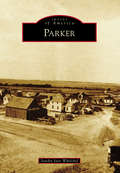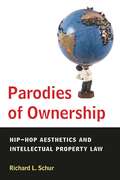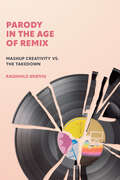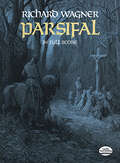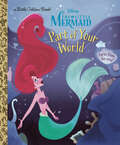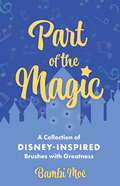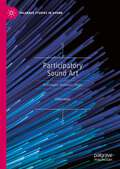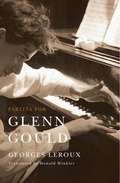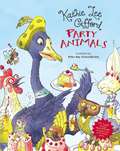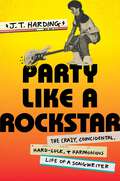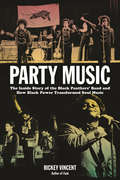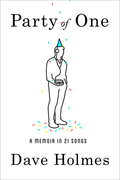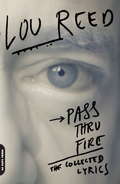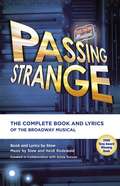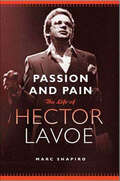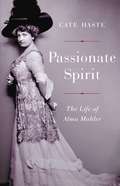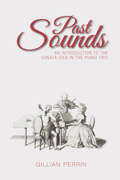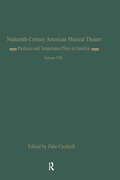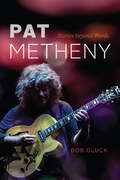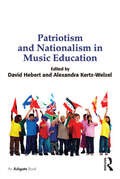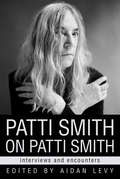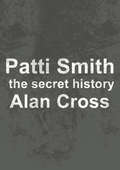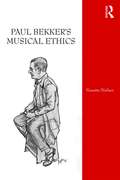- Table View
- List View
Parker
by Sandra Jane WhelchelThe town of Parker underwent several name changes before adopting its current title. First called Pine Grove for its setting in a copse of ponderosa pines at the northern edge of Colorado's Black Forest, that name lasted through the final days of stagecoach travel. When the US Post Office officially began operations in the 1880s, officials requested that Pine Grove be renamed, as another town with that name existed on the Platte River, causing the mail to be mixed up. James Sample Parker requested that the town's name be changed to Edithville, in honor of his young daughter. Again, the US Post Office denied the request, renaming the town Parker to recognize James Sample Parker and his brother, George. From these early beginnings, Parker faced spurts of growth and recession, more recently becoming a significant Denver suburb.
Parodies of Ownership: Hip-Hop Aesthetics and Intellectual Property Law
by Richard L. SchurWhat is the relationship between hip-hop and African American culture in the post--Civil Rights era? Does hip-hop share a criticism of American culture or stand as an isolated and unique phenomenon? How have African American texts responded to the increasing role intellectual property law plays in regulating images, sounds, words, and logos? Parodies of Ownership examines how contemporary African American writers, artists, and musicians have developed an artistic form that Schur terms "hip-hop aesthetics." This book offers an in-depth examination of a wide range of contemporary African American painters and writers, including Anna Deavere Smith, Toni Morrison, Adrian Piper, Colson Whitehead, Michael Ray Charles, Alice Randall, and Fred Wilson. Their absence from conversations about African American culture has caused a misunderstanding about the nature of contemporary cultural issues and resulted in neglect of their innovative responses to the post--Civil Rights era. By considering their work as a cross-disciplinary and specifically African American cultural movement, Schur shows how a new paradigm for artistic creation has developed. Parodies of Ownership offers a broad analysis of post--Civil Rights era culture and provides the necessary context for understanding contemporary debates within American studies, African American studies, intellectual property law, African American literature, art history, and hip-hop studies. Weaving together law, literature, art, and music, Schur deftly clarifies the conceptual issues that unify contemporary African American culture, empowering this generation of artists, writers, and musicians to criticize how racism continues to affect our country.
Parody in the Age of Remix: Mashup Creativity vs. the Takedown
by Ragnhild BrøvigThe art of mashup music, its roots in parody, and its social and legal implications.Parody needn&’t recognize copyright—but does an algorithm recognize parody? The ever-increasing popularity of remix culture and mashup music, where parody is invariably at play, presents a conundrum for internet platforms, with their extensive automatic, algorithmic policing of content. Taking a wide-ranging look at mashup music—the creative and technical considerations that go into making it; the experience of play, humor, enlightenment, and beauty it affords; and the social and legal issues it presents—Parody in the Age of Remix offers a pointed critique of how society balances the act of regulating art with the act of preserving it.In several jurisdictions, national and international, parody is exempted from copyright laws. Ragnhild Brøvig contends that mashups should be understood as a form of parody, and thus be protected from removal from hosting platforms. Nonetheless, current copyright-related content-moderation regimes, relying on algorithmic detection and automated decision making, frequently eliminate what might otherwise be deemed gray-area content—to the detriment of human listeners and, especially, artists. Given the inaccuracy of takedowns, Parody in the Age of Remix makes a persuasive argument in favor of greater protection for remix creativity in the future—but it also suggests that the content-moderation challenges facing mashup producers and other remixers are symptomatic of larger societal issues.
Parsifal in Full Score
by Richard WagnerCompleted in 1882, Parsifal is Wagner's last opera and one of his finest, renowned for its splendid music and glowing orchestration. With its deeply personal treatment of the legend of the Holy Grail, and the subtle intensity and depth of compassion of its treatment of themes of innocence and purity, remorse and sexual renunciation, the opera ranks as one of Wagner's most symbolic, intense, and compassionate works.This Dover edition reproduces every note of this glorious masterpiece from the authoritative C. F. Peters edition, including the list of characters and contents in both German and English. It will be welcomed by musicians, music lovers, opera buffs, and admirers of Wagner as the only complete, inexpensive edition of a 19th-century landmark.
Part of Your World (Little Golden Book)
by Howard Ashman Alan MenkenSing along to the iconic Disney song "Part of Your World" from The Little Mermaid with this beautifully illustrated Little Golden Book. Perfect for children ages 2 to 5!Dive under the sea and join Disney Princess Ariel as she dreams about what it would be like to join the human world! This beautiful Little Golden Book features the lyrics to the beloved song "Part of Your World" as well as illustrated scenes from the movie and is sure to be a treasure for children ages 2 to 5 as well as Little Golden Book collectors and Disney fans of all ages.Little Golden Books enjoy nearly 100% consumer recognition. They feature beloved classics, hot licenses, and new original stories. . . the classics of tomorrow.
Part of the Magic: A Collection of Disney-Inspired Brushes with Greatness
by Bambi MoéPart of the Magic: A Collection of Disney-Inspired Brushes with Greatness is a book of remarkable and wildly entertaining anecdotal stories told through the lens of an entertainment industry insider. Author Bambi Moé enjoyed a twenty-year career at The Walt Disney Company in charge of all aspects of music for Walt Disney Television Animation. Her name, vocation, and background gave her exceptional access to pop culture and entertainment giants. The book takes readers on a nonstop ride and keeps them riveted throughout extremely candid encounters shared here for the first time. Moé’s fascinating true stories provide a rare insight into the creative process associated with music in animation and give readers a historical reference to The Walt Disney Company’s burgeoning direct-to-video empire. Her career exemplifies the rewards often associated with hard work, perseverance, integrity, and the ability to recognize potential in others. Often the only woman in a male-dominated work environment, Moé’s success will inspire young readers interested in pursuing a career in entertainment. Part of the Magic invites readers to consider their own stories and recognize their own universality. Like a photo that captures life’s moments and teaches us lessons, each of Moé’s brushes with greatness serves as a reminder that we are all connected by reason of our own humanity. Her joy extends far beyond the original encounter and multiplies in the retelling of these stories.
Participatory Sound Art: Technologies, Aesthetics, Politics (Palgrave Studies in Sound)
by Vadim KeylinThis book addresses a major gap in sound art scholarship: the role of audience participation. It offers a survey of participatory sound art from its origins in the historical avant-gardes to the non-institutionalized forms of sonic creativity in contemporary digital culture. In doing so, it proposes an innovative theoretical framework for analysing such phenomena, rooted in Pragmatist aesthetics, affordance theory and postcritique. Combining artwork analyses with qualitative studies, it focuses on three principal aspects of participatory sound art: the ways the materialities of the artworks facilitate and structure the participatory processes; the interplay of the creative agencies of the artists and the participants; and the postcritical approach to sound art’s politics, unfolding through the participants’ affective gestures. In considering these multiple dimensions, this book contributes to the growing fields of sound studies and participation studies, as well as to curatorial practice regarding sound art and participatory art.
Partita for Glenn Gould: An Inquiry into the Nature of Genius
by Georges LerouxGlenn Gould (1932-1982) was a giant of twentieth-century classical music, but one whose eccentricities have sometimes obscured the moral seriousness of his approach to art. Countering this common misperception, Partita for Glenn Gould is an eloquent tribute to the artist that illuminates his versatile genius, his thinking, and our reasons for loving his art.
Party Animals
by Kathie Lee GiffordSuccessful talk show host, singer, songwriter, actress, and author Kathie Lee Gifford has come up with a delightful book for children! Lucy Goosy is carefully reviewing her list of animals to invite for her birthday party. She has to make sure to invite the right guests so that her party will be perfect. But when she focuses on everyone’s bad qualities, instead of good, she discovers that there is no one to attend! With a little help from the Wise Owl, Lucy Goosy discovers it is our special characteristics that make us unique. Written in adorable sing-song rhyme, Kathie Lee Gifford’s new picture book for children teaches us that we are all special because we are different! This endearing book comes with a CD, where the accompanying song "Party Animals” is performed by the author so kids can read and sing along with the music.
Party Like a Rockstar: The Crazy, Coincidental, Hard-Luck, and Harmonious Life of a Songwriter
by J.T. HardingThis fun and fast-paced rock-and-roll memoir from hit singer-songwriter J.T. Harding shows what it takes to go from South Detroit to the top of the Nashville charts.In PARTY LIKE A ROCKSTAR, J.T. Harding charts his life from a kid growing up in Michigan to a chart-topping songwriter living in Nashville and working with country music stars like Keith Urban and Kenny Chesney. As a kid playing rock n' roll in his parents' garage, Harding's was a world in which every taste of new music—from KISS to Prince and everyone in between—was a revelation. Inspired by his favorite artists, Harding abandons the classic "American Dream" and runs away to Los Angeles, where he forms a band and becomes part of the music scene there, all the while selling records to his favorite artists and producers at Tower Records.A story of youth, rebellion, and determination, PARTY LIKE A ROCKSTAR is a memoir for music lovers and an invaluable how-to guide for anyone who wants to learn how to write a hit song. Fun and heartfelt, Harding's memoir is the story of one man's unshakable love for rock and roll, how it guided him through some of the greatest tragedies—and greatest triumphs—of his wild and unvarnished life.
Party Music: The Inside Story of the Black Panthers' Band and How Black Power Transformed Soul Music
by Boots Riley Rickey VincentExamining the culture and politics of the Black Power era of the late 1960s, this book explores the relationship of soul music to the Black Power movement from the vantage point of the musicians and black revolutionaries themselves. The 1960s were a turbulent time for race relations in the United States, but no other area in the country epitomized the radical social change that was taking place more than the San Francisco Bay Area--the epicenter of the Black Panthers movement. This social history introduces fans of soul music and 20th-century U.S. history enthusiasts to the Black Panthers' own band, the Lumpen, a group comprised of rank-and-file members of the Oakland, California-based Party. During their year-long tenure, the Lumpen produced hard-driving rhythm-and-blues that asserted the revolutionary ideology of the Black Panthers. Through his rediscovery of the Lumpen, and based on new interviews with Party and band members, author Rickey Vincent provides an insider's account of Black Power politics and soul music aesthetics in an original narrative that reveals more detail about the Black Revolution than ever before.
Party of One: A Memoir in 21 Songs
by Dave HolmesFrom former MTV VJ Dave Holmes, the hilarious memoir of a perpetual outsider fumbling towards self-acceptance, with the music of the '80s, '90s, and today as his soundtrack Dave Holmes has spent his life on the periphery, nose pressed hopefully against the glass, wanting just one thing: to get inside. Growing up, he was the artsy son in the sporty family. At his all-boys high school and Catholic college, he was the closeted gay kid surrounded by crush-worthy straight guys. And in his twenties, in the middle of a disastrous career in advertising, he accidentally became an MTV VJ overnight when he finished second, naturally, in the Wanna Be a VJ contest, opening the door to fame, fortune, and celebrity--you know, almost. In Party of One, Holmes tells the hilariously painful and painfully hilarious tales--in the vein of Rob Sheffield, Andy Cohen, and Paul Feig--of an outsider desperate to get in, of a misfit constantly changing shape, of a music geek who finally learns to accept himself. Structured around a mix of hits and deep cuts from the last four decades--from Bruce Springsteen's "Hungry Heart" and En Vogue's "Free Your Mind" to LCD Soundsystem's "Losing My Edge" and Bleachers' "I Wanna Get Better"--and punctuated with interludes like "So You've Had Your Heart Broken in the 1990s: A Playlist" and "Notes on (Jesse) Camp," this book is for anyone who's ever felt like a square peg, especially those who have found their place in the world around a band, an album, or a song. It's a laugh-out-loud funny, deeply nostalgic story about never fitting in, never giving up, and letting good music guide the way.
Party of One: A Memoir in 21 Songs
by Dave HolmesFrom former MTV VJ Dave Holmes, the hilarious memoir of a perpetual outsider fumbling towards self-acceptance, with the music of the '80s, '90s, and today as his soundtrack Dave Holmes has spent his life on the periphery, nose pressed hopefully against the glass, wanting just one thing: to get inside. Growing up, he was the artsy son in the sporty family. At his all-boys high school and Catholic college, he was the closeted gay kid surrounded by crush-worthy straight guys. And in his twenties, in the middle of a disastrous career in advertising, he accidentally became an MTV VJ overnight when he finished second, naturally, in the Wanna Be a VJ contest, opening the door to fame, fortune, and celebrity--you know, almost. In Party of One, Holmes tells the hilariously painful and painfully hilarious tales--in the vein of Rob Sheffield, Andy Cohen, and Paul Feig--of an outsider desperate to get in, of a misfit constantly changing shape, of a music geek who finally learns to accept himself. Structured around a mix of hits and deep cuts from the last four decades--from Bruce Springsteen's "Hungry Heart" and En Vogue's "Free Your Mind" to LCD Soundsystem's "Losing My Edge" and Bleachers' "I Wanna Get Better"--and punctuated with interludes like "So You've Had Your Heart Broken in the 1990s: A Playlist" and "Notes on (Jesse) Camp," this book is for anyone who's ever felt like a square peg, especially those who have found their place in the world around a band, an album, or a song. It's a laugh-out-loud funny, deeply nostalgic story about never fitting in, never giving up, and letting good music guide the way.From the Hardcover edition.
Pass Thru Fire: The Collected Lyrics
by Lou ReedContaining a body of work that spans more than three decades, Pass Thru Fire is a stunning collection of the lyrics of an American original. Through his many incarnations-from proto punk to glam rocker to elder statesman of the avant garde-Lou Reed's work has maintained an undeniable vividness and raw beauty, fueled by precise character studies and rendered with an admirable shot of moral ambiguity. Beginning with his formative days in the Velvet Underground and continuing through his remarkable solo career-albums like Transformer, Berlin, New York, Magic and Loss, and Ecstasy-Pass Thru Fire is crucial to an appreciation of Lou Reed, not only as a consummate underground musician, but as one of the truly significant poets of our time.
Passing Strange: The Complete Book and Lyrics of the Broadway Musical
by StewThe innovative new musical won the 2008 Tony Award for Best Book and is soon to be a Spike Lee film.
Passion and Pain: The Life of Hector Lavoe
by Marc ShapiroA definitive biography of Hector Lavoe's rise from Puerto Rico to stardom in New York that led to sold-out concerts and best-selling salsa albums, yet gave way to drug addiction, a strained marriage and tragedy.From the poverty-stricken streets of Ponce, Puerto Rico to the vibrant barrios of New York City, HECTOR LAVOE became the singer of all singers, and the driving-force behind the Salsa movement in the mid-1960s. His popularity rivaled that of his contemporaries, Tito Puente, Celia Cruz and Johnny Pacheco.Behind the music, Hector's life was filled with drugs, alcohol and women. An endless stream of tragedy plagued him, including a gun-related accident that killed his son, Hector's ninth floor jump from a hotel window, and his death in 1993 from AIDS. But Hector's pristine voice, one-of-a-kind stage performances, sold-out concerts and bestselling albums were what his fans remember most and what made him an international icon. His music brought joy to legions of people, and it continues today.Marc Shapiro's Passion and Pain is "A no-holds barred biography" (Uptown Magazine) of a fascinating life.
Passion for the Piano
by Judith OringerEvolution of the piano, its manufacturing, care of a piano, piano competitions, the piano in literature and films, and politics and the piano.
Passionate Spirit: The Life of Alma Mahler
by Cate HasteA new biography of Alma Mahler (1879-1964), revealing a woman determined to wield power in a world that denied her agency History has long vilified Alma Mahler. Critics accused her of distracting Gustav Mahler from his work, and her passionate love affairs shocked her peers. Drawing on Alma's vivid, sensual, and overlooked diaries, biographer Cate Haste recounts the untold and far more sympathetic story of this ambitious and talented woman. Though she dreamed of being the first woman to compose a famous opera, Alma was stifled by traditional social values. Eventually, she put her own dreams aside and wielded power and influence the only way she could, by supporting the art of more famous men. She worked alongside them and gained credit as their muse, commanding their love and demanding their respect. Passionate Spirit restores vibrant humanity to a woman time turned into a caricature, providing an important correction to a history where systemic sexism has long erased women of talent.
Past Sounds: An Introduction to the Sonata Idea in the Piano Trio
by Gillian PerrinThis is a book about classical music – for people who say they love music “but don’t understand how it works”, as well as for performers and music students of all ages. Proposing that deeper enjoyment begins with an understanding of music’s basic structures, the book describes how the simple template of earlier dance-songs was adapted by composers writing music for instruments. The instrumental sonata became one of the great formal frameworks of western music: in symphonies, concertos, chamber music and solo sonatas, it dominated concert music for some 250 years – yet it is little understood by many music lovers. To simplify this vast field, Past Sounds singles out for study “sonatas” for piano trio – piano, violin and ’cello. These instruments have well-contrasted and easily identifiable sounds, and as the story unfolds the reader is introduced to many rarely heard but beautiful works for piano trio. This is a lively, clearly-written narrative as well as a handbook for subsequent listening. The book has two distinctive features. Firstly, technical terms are carefully explained, and for those not familiar with music notation, audio clips in an accompanying website reproduce the actual sound of the music described. Secondly, in a broad historical sweep from mid-18th to 20th centuries, the development of the sonata is followed in its context of contemporary arts and literature – demonstrating how the sonata idea of classical music well deserves to be understood and valued as a western cultural archetype alongside other great artistic and literary forms.
Pasticcio and Temperance Plays in America: Il Pesceballo (1862) and Ten Nights Volume 8 (Nineteenth-Century American Musical Theater Series)
by Dale CockrellThe series aims to represent all the major genres and styles of musical theater of the century, from ballad opera through melodrama, plays with incidental music, parlor entertainments, pastiche, temperance shows, ethnic theater, minstrelsy, and operetta, to grand opera. This series of sixteen volumes provides for the first time ever a comprehensive set of works from a full century of musical theater in the United States of America. The two works in this volume seemingly have little in common. They reflect the society in which they were created in quite different ways. Il Pesceballo is an intelligent and subtle parody of operatic conventions, closer to the tradition of literary burlesque. Ten Nights in a Bar-Room is a play with interpolated song, a theatrical vehicle for moral evangelizing. The first, by America’s first great ballad scholar, remained practically unknown and unperformed; the second, by a forgotten actor/playwright, became legendary and widely embedded in the American cultural heritage. Yet both share at least two important features. One is their incorporation of easily recognized music. The works are also related through the purposes for which they were completed and performed.
Pat Metheny: Stories beyond Words
by Bob GluckAn in-depth exploration of the style and influence of Pat Metheny, a truly distinctive musical voice of our time. Guitarist and composer Pat Metheny, among the most acclaimed, visionary musicians of our time, has for five decades toured with his many creative musical projects, most prominently the Pat Metheny Group, while collaborating with celebrated artists, including Charlie Haden, Ron Carter, Herbie Hancock, Ornette Coleman, and Steve Reich. Bob Gluck, whose perspective as pianist, composer, and educator has illuminated the music of Herbie Hancock and Miles Davis in his two previous books, now focuses his lens on the music of Metheny. Neither a biography nor chronological record of Metheny’s musical output, Pat Metheny: Stories beyond Words instead captures Metheny’s self-conception as a musician and the threads that unite and distinguish his creative process. Drawing upon a wealth of new interviews and close readings of musical examples, Gluck offers a bird’s-eye view of Metheny’s musical ideas. Among these are the metaphor of storytelling, the complementarity of simplicity and complexity, and the integrated roles of composer, performer, and band leader. Much like Metheny’s signature style, this book is accessible to a wide range of readers, presenting new clarity, musical insight, and historical perspective about the legacy of Metheny’s groundbreaking music.
Patriotism and Nationalism in Music Education
by David G. Hebert Alexandra Kertz-WelzelMusic has long served as an emblem of national identity in educational systems throughout the world. Patriotic songs are commonly considered healthy and essential ingredients of the school curriculum, nurturing the respect, loyalty and 'good citizenship' of students. But to what extent have music educators critically examined the potential benefits and costs of nationalism? Globalization in the contemporary world has revolutionized the nature of international relationships, such that patriotism may merit rethinking as an objective for music education. The fields of 'peace studies' and 'education for international understanding' may better reflect current values shared by the profession, values that often conflict with the nationalistic impulse. This is the first book to introduce an international dialogue on this important theme; nations covered include Germany, the USA, South Africa, Australia, Finland, Taiwan, Singapore and Canada.
Patti Smith on Patti Smith: Interviews and Encounters (Musicians in Their Own Words)
by Aidan LevyFrom the moment Patti Smith burst onto the scene, chanting "Jesus died for somebody's sins, but not mine," the irreverent opening line to Horses, her 1975 debut album, the punk movement had found its dissident intellectual voice. Yet outside the recording studio—Smith has released eleven studio albums—the punk poet laureate has been perhaps just as revelatory and rhapsodic in interviews, delivering off-the-cuff jeremiads that emboldened a generation of disaffected youth and imparting hard-earned life lessons. With her characteristic blend of bohemian intellectualism, antiauthoritarian poetry, and unflagging optimism, Smith gave them hope in the transcendent power of art. In interviews, Smith is unfiltered and startlingly present, and prescient, preaching a gospel bound to shock or inspire. Each interview is part confession, part call-and-response sermon with the interviewer. And there have been some legendary interviewers: William S. Burroughs, Thurston Moore (of Sonic Youth), and novelist Jonathan Lethem. Her interview archive serves as a compelling counternarrative to the albums and books. Initially, interviewing Patti Smith was a censorship liability. Contemptuous of staid rules of decorum, no one knew what she might say, whether they were getting the romantic, swooning for Lorca and Blake, or the firebrand with no respect for an on-air seven-second delay. Patti Smith on Patti Smith is a compendium of profound and reflective moments in the life of one of the most insightful and provocative artists working today.
Patti Smith: The Secret History (The\secret History Of Rock Ser.)
by Alan CrossAlan Cross is the preeminent chronicler of popular music.Here he provides a history of Patti Smith, Godmother of Punk."The High Punk Priestess of New York" looks at her influence and is adapted from the audiobook of the same name.
Paul Bekker's Musical Ethics
by Nanette NielsenGerman music critic and opera producer Paul Bekker (1882–1937) is a rare example of a critic granted the opportunity to turn his ideas into practice. In this first full-length study of Bekker in English, Nanette Nielsen investigates Bekker's theory and practice in light of ethics and aesthetics, in order to uncover the ways in which these intersect in his work and contributed to the cultural and political landscape of the Weimar Republic. By linking Beethoven's music to issues of freedom and individuality, as he argues for its potential to unify the masses, Bekker had already in 1911 begun to construct the ethical framework for his musical sociology and opera aesthetics. Nielsen discusses some of the complex (and conflicting) layers of modernism and conservatism in Bekker that would have a continued presence in his work and its reception throughout his career. Bekker's demands for a 'practical ethics' led to his criticisms of metaphysically grounded approaches to aesthetics, and his ethical views are put into further relief in a sketch of the development of his music phenomenology in the 1920s. Nielsen unravels the complex intersections between Bekker's ethics and his opera aesthetics in connection with his practice as an Intendant at the Wiesbaden State Theatre (1927–1932), offering a critical reading of an opera staged during his tenure: Hugo Herrmann’s Vasantasena (1930). Further works are considered in light of the theoretical framework underpinning the book, inspired by several intersections between ethics and aesthetics encountered in Bekker's work.
